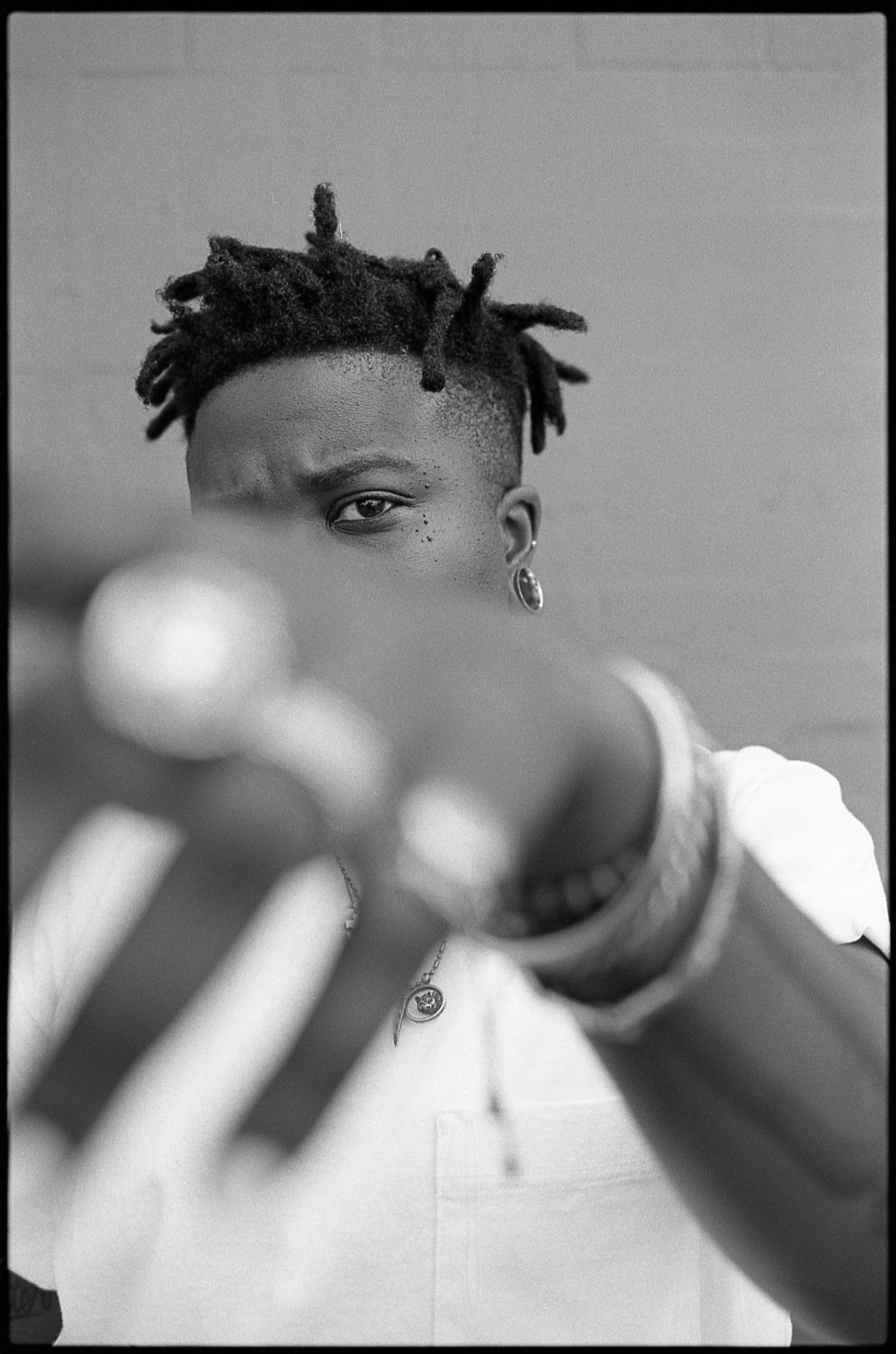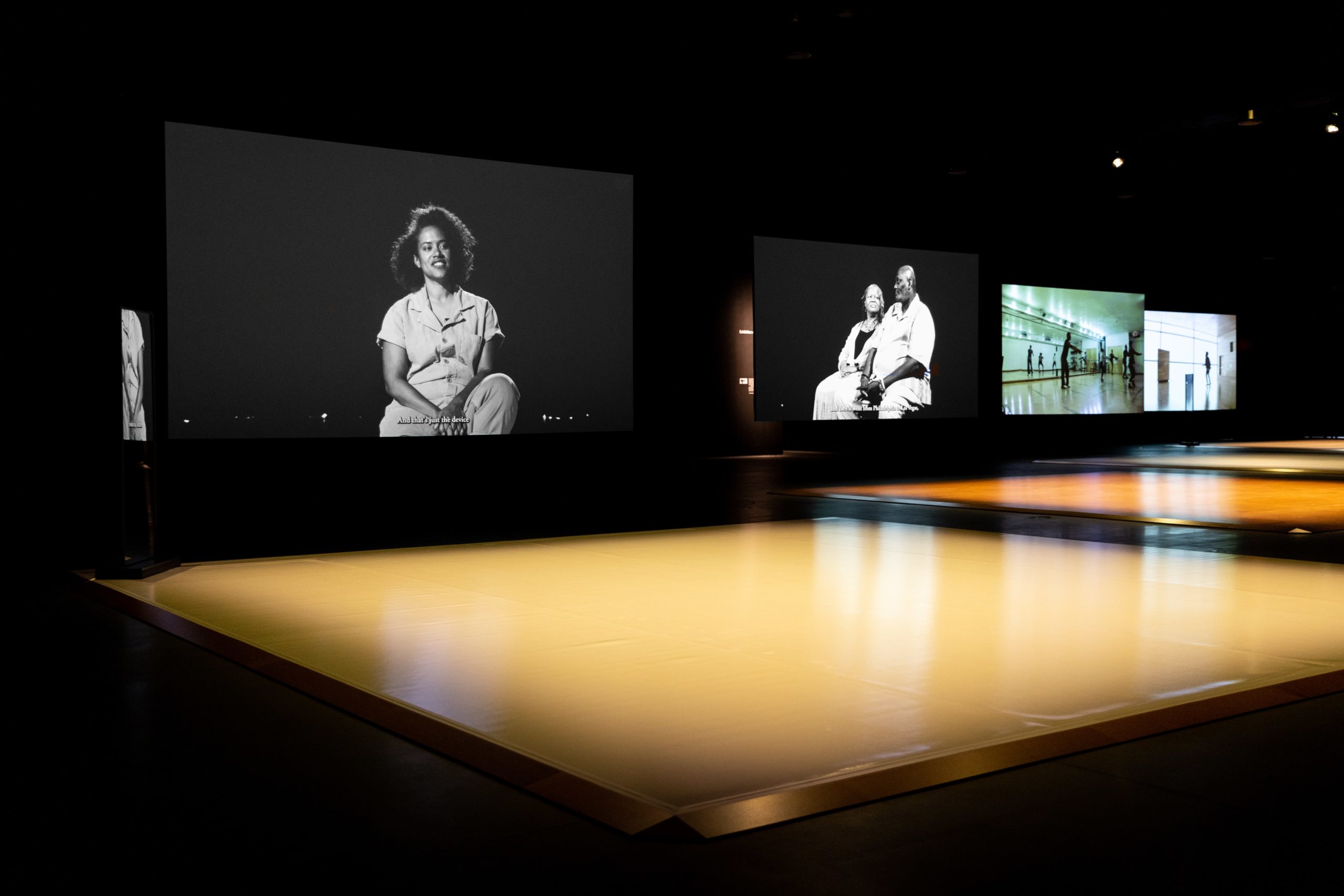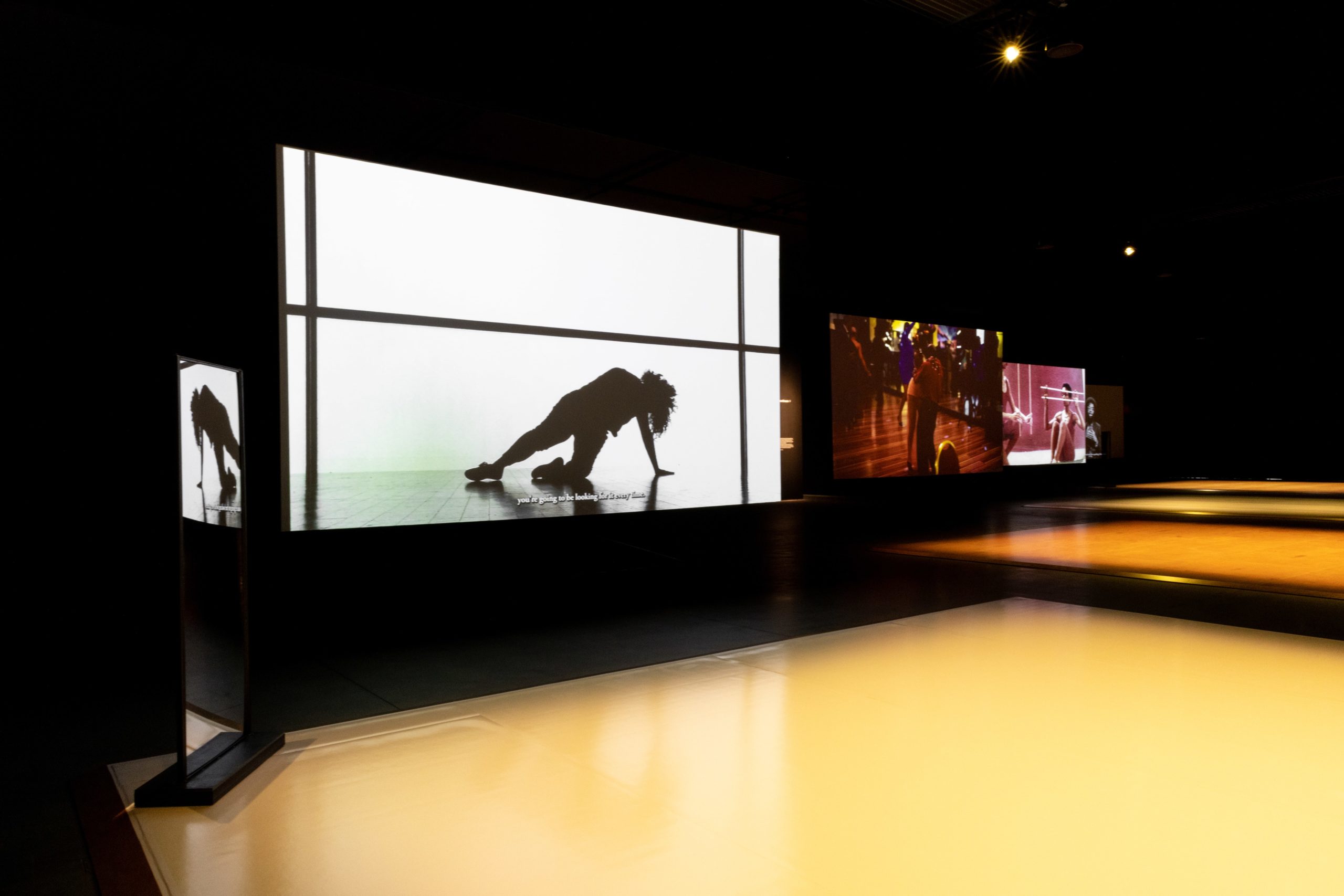Currently, in New York City, Tiona Nekkia McClodden has not one, but two exhibitions on view. Each is distinct in its message and represents the powerful nature of her dynamically widespread practice. At the art space 52 Walker, “MASK / CONCEAL / CARRY” (open through October 8), approaches its titular themes from a more personal standpoint. And at The Shed, the artist looks at Black joy through the lens of dance by highlighting the 1983 Dance Black America festival in a presentation titled “The Trace of an Implied Presence” (on view until December 11). The exhibition was crafted with the insight of the event’s original producer, former Executive Producer of the Apollo Theater Mikki Shepard, along with a featured cast of dancers, some of whom were participants in the original festival.
The Philadelphia-based artist lets her topic of choice do the talking, tied together by a personal manifesto of sorts that focuses on “Black mentifact”—in short, the artist’s look at the communal values and thought ways of the African diaspora. McClodden then chooses the medium that seems best fit to convey the story at hand. “The Trace of an Implied Presence” at the Shed was born from an exploratory visit to the Hamm Archives at the Brooklyn Academy of Music (BAM). Focusing on the world of Black dance through the history of the festival, which was a landmark performance event showcasing centuries of Black American dance traditions, the narrative now unfolds in the cavernous exhibition space at The Shed. Situated in a line, four video projections hover above four dance floors, almost like stages. Engulfed in the shadows of the videos, the installation invites its audience to set foot on the various surfaces, which have been carefully selected to correspond with the type of dance highlighted in the work above. They will also serve as the site of a program of special demonstrations that accompany the exhibition.
To create the four videos, McClodden worked in collaboration with dancer and choreographer Leslie Cuyjet, scholar and tap dancer Michael J. Love, experts in the regional social dance the Philly Bop Audrey and June Donaldson, and the Rod Rodgers Dance Company. Just ahead of one of the exhibition’s events—like an instructional class on the Philly Bop—Whitewall recently conversed with the McClodden where she shared more about her process and key details, like how she has invited the dancers of New York City to employ the installation as their own dance studio.

Portrait of Tiona Nekkia McClodden by Gioncarlo Valentine.
WHITEWALL: When did you first realize you wanted to enact an exhibition around the 1983 Dance Black America Festival?
TIONA NEKKIA MCCLODDEN: When I saw how dynamic the [Hamm] Archive was, and actually quite frankly how small it was—it was very distilled, it’s just extraordinarily and exceptionally organized by Mikki Shepard—that’s when I knew that I needed to give some attention. I met with her to talk to her about this archive and talk about that experience and think about what that time was in the 80s and what was at stake at the time—especially with Black dance, I felt like I should do it.
It was a big commitment because I’m a non-dancer [laughs] with a very limited understanding of Black dance in a real way. So, I felt like it would throw me into something I would really have to study. That was exciting for me.
WW: So, it was really your conversation with Mikki that was the catalyst for the exhibition?
TNM: Yeah. This is just my process. I didn’t know what form it would be. The form that is up now is way different from anything that I ever thought it could be when I first met with Mikki. I really think that’s important to give a particular kind of clarity around the way that I work, but also what people are seeing right now.
WW: After your initial discussion, what role did Mikki play in the show and your creative process?
TNM: We had several conversations. Citational material is usually static—you’re taking something from a book, you’re taking something from a document in that way. And I wanted something in a relationship with her where the citation is living and there’s a different kind of accountability.
The way she shows up in the exhibition, she cuts through the actual video portraits that I have of the dancers, like every 30 minutes and talks about the reality—not only of the festival and some of the people who were involved in the festival but also her positionality in relationship to Black dance.

Installation view, “Tiona Nekkia McClodden: The Trace of an Implied Presence,” The Shed, New York, August 4 – December 11, 2022; artwork © Tiona Nekkia McClodden, photo by Maria Baranova; courtesy of The Shed.
WW: As someone with limited knowledge of dance, how did the works evolve from that initial discovery period to what we’ll find on view at The Shed?
TNM: After I took stock in what took place in ’83 with the festival [and] the limited understanding of what I could see of the performances, I realized I would be at risk for something that was a bit too nostalgic if I didn’t engage with dance as it exists today.
I had my Philly Bop dancers as well as Rod Rodgers, they were part of my original iteration immediately. But Leslie Cuyjet and Michael J. Love came on later because I realized I needed to look at Black dance that still [has] a little bit of trouble in its contextualization.
Leslie does kind of improvisational, contemporary modern dance. I think that sometimes that can fall to the wayside because of its experimental nature and not be contextualized or handled well in general. But specifically, within the Black community. I wanted to kind of give room to show what that looks like and also allow Leslie to talk about it.
And on the other end, that’s more extreme, is tap dance. Tap dance is stereotypical and historical because of the ways it enters into the American historical view as this thing that is also kind of tied to minstrelsy. And it still holds that trouble. The gift that I had in Michael is that he’s not only a tap dancer but he’s a scholar, so he’s had a hand in contextualizing himself and his peers.
WW: You’ve extended an invitation for people to come in, make use of the space, and document their own numbers. What does that look like?
TNM: If folks come in, they’re dancing there at their own will. If they want to prop up a camera and film themselves dancing that’s what they can do. I’ve encouraged a lot of performers and dancers who need the space. I was like, “Look, there’s four dance floors up there. You get to do whatever you want outside of the performances that are happening.”
The general offer to the larger dance community is that these floors are here, there’s four different kinds of floors tailored to four different types of dance. If you do need that kind of room—especially with a tap dancer—you can come in this place any time and go to work and use that as an opportunity to practice, use it as an opportunity to perform, or use it as an opportunity to do what dancers really need—documentation that they can move around to get gigs. That’s kind of the grounding for that.
WW: And have you seen many people interacting with the dance floors? What has their response meant to you as the artist?
TNM: On the opening, it was pretty lovely because people were immediately on there. That opening was probably one of the more dynamic things I’ve ever seen. They had their shoes off… even Audrey and June, my Philly Bop dancers, were immediately teaching people on the floor how to do the dance.
That immediate exchange of dance and the sharing of the archive through the physical body—that’s when I knew, “Okay, this is working.” Even within the portrait, because people were very much taken by their floors. They were very much engaging in a particular way that let me know it was possible to have something like this. There was no request for any kind of performance from my dancers at the opening at all, [so] to have them feel like they wanted to dance made me feel really good.

Installation view, “Tiona Nekkia McClodden: The Trace of an Implied Presence,” The Shed, New York, August 4 – December 11, 2022; artwork © Tiona Nekkia McClodden, photo by Maria Baranova; courtesy of The Shed.
WW: How did your relationship to dance evolve during this process?
TNM: Well, in 2018 when I did the Philly Bop documentation that I did (it was like a photography- and a video-based thing) I learned the Bop [laughs]. I had to learn the dance because I felt like I really needed to learn that dance in order to film it. I just came to this realization, I was like, “This is not gonna work unless I get it in my body.”
So I was going to classes without a camera for a couple of months just trying to make sense of how it worked. It’s something I’m still doing. I’ve had to go back to classes to get ready for tomorrow because I’m so rusty.
WW: Then you’ll be doing the Philly Bop at the event?
TNM: Yeah, I’ll be there. I’ll be there moving awkward. [laughs] You know this is the one I can participate in. There is no way in hell you’ll ever see me tap dance. But the Philly Bop, I like that dance and I like that I know how to do it, even though I’m not the best at it.
I don’t know, it just made me feel more drawn to dance. It’s something I’ve always enjoyed seeing. I love to see dance and I like to see a lot of different kinds of dance. I think it’s probably one of the things that I miss the most in this pandemic moment, being able to go see people who are dancers dance. There’s something about the liveness I’ve always admired. I like that I’ve created something where I can go and see dance for months. I really do like that.








